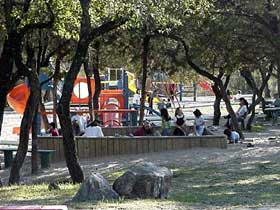
Vol. III, No. 4, April 2004
What Makes Outdoor Sand Play Work?
 Children
have been playing in sand for many centuries. It is difficult to beat the
sensory experience that young children get from being immersed in sand play.
Children
have been playing in sand for many centuries. It is difficult to beat the
sensory experience that young children get from being immersed in sand play.
Here are some considerations to keep in mind for sand play on your play yard:
- Locate the sandbox in a shady area, preferably away from the building
- Locate the sandbox away from high traffic areas
- Go to the gravel company and select your own sand-you are looking for a mix that brushes off easily
- Consider ADA access into the sandbox by providing a transfer deck for children using wheelchairs
- Provide 6" steps into the sandbox for toddlers, two's or children with mobility problems
- Remember to provide access to your sand box by truck to replenish the sand as needed
- Provide a cover for your sandbox, both Grounds for Play and Benee's Toys make custom sand box covers. As a last resort, use a tarp weighted down with bricks.
- Provide a ledge for teachers to sit on around the outside-this also makes a great roadway
- Develop rules for the use of the sandbox
- Provide numerous and ample props for the children to experiment
- Replace the sand every two years with clean sand. Do not sanitize with chemicals
Some parents are opposed to the use of sand since it might be difficult to remove the sand from children whose hair might be braided or if pom-aid is used to help in the braiding. Sometimes a shower cap can be utilized to protect the hair. Other sensory experiences that can be provided outdoors in the place of sand might be pine cones, larger smooth rocks, leaves or with older children pea gravel. Pea gravel is not recommended for younger children as they will put it in their nose and ears.
Sand is usually sold by the cubic yard. To calculate the amount you need,
multiply the length (in feet) times the width (in feet) times the depth (in
feet). This will give you the number of cubic feet you need. For each 27 cubic
feet (or fraction thereof) you will need one cubic yard of sand. For examples,
a sand box that is seven feet wide, nine feet long and one foot deep would
be calculated: 7' x 9'=63 x 1'=63. 63 square feet divided
by 27=2.3 cu yds. One would need three cubic yards of sand. Depending on how
high the sides of your sand box are, you might have areas of sand, such as
in the middle, that are deeper than 12 inches. It is wise to order more sand
that you need since you might need to also replenish your indoor sand tables
at the same time.

